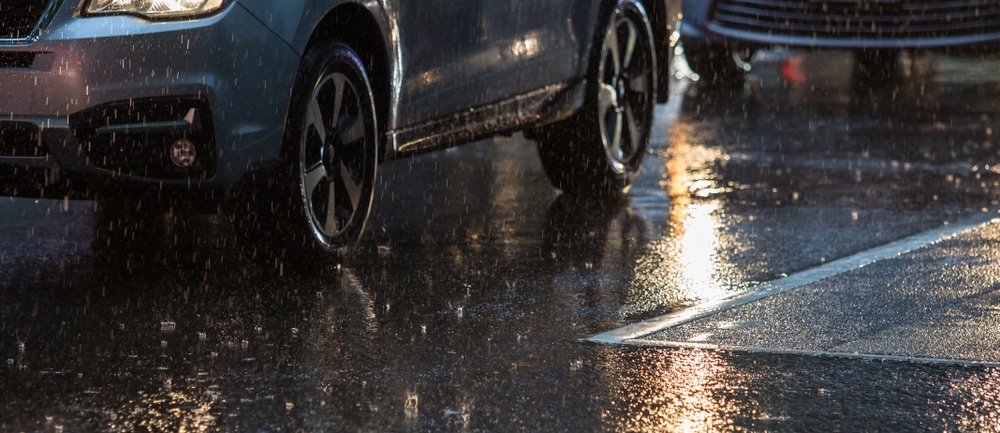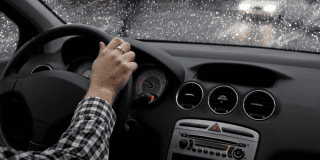How to Drive This Winter in California’s Rain, Ice or Snow
Welcome to another California winter. If you lived in North Dakota or the Florida Keys, you might know exactly what to expect from the elements. In the Golden State, however, you could have a whole different seasonal driving experience depending on whether you live in San Diego, Sacramento, or Shasta County. So you need car insurance that stands up to your winter driving reality.
Here’s a touch of what you might have in store while traipsing across California, and what you can do to prepare.
Hydroplaning When You Thought You Were in Control
There’s little that’s more terrifying than realizing your steering wheel isn’t making road contact. You feel more like a helpless passenger than a driver in charge. It’s called hydroplaning.
You’re literally not in charge when your car is driving on top of a micro-thin layer of water rather than directly on the pavement. This phenomenon happens during heavy rainstorms or floods, the kind that can take place throughout California during the winter season. Sometimes rain falls so fast and so constantly that you’re actually driving on top of it. This might only happen for a handful of seconds, but it can be startling.
The key is to stay cool. Tap your brakes, but don’t floor them. That could put your vehicle into a skid or a totally out-of-control spin.
Two things in your favor: You have a warning, and the phenomenon probably won’t last long. What we mean by a warning is that you should assume hydroplaning could occur whenever you drive into a hard rain. Start taking cautions immediately. Drive slowly and with even more alertness than usual. Better yet, pull off the road and wait it out if you can. Rains that intense typically don’t last long.
As for that second advantage, as long as you don’t panic as it’s occurring, you should be out of the adrenaline-jolting condition soon.

Driving in CA Snow
California is a state where snow doesn’t fall regularly (or at all, depending on your location). That might be the very reason you moved here. It might also be why your relatives from Michigan and Minnesota try to visit every December and January.
The only downside to such infrequent snowfall (besides your kids’ lack of snow fort construction skills) is that you’re not nearly as prepared to drive in such conditions.
Snowfall causes poor visibility and slippery driving conditions. Visibility can drop to near zero during a heavy storm. Add strong wind, and the result is snow squalls that can make things even worse, including swerving and shimmying your car on the road.
There’s slippery stuff under your tires, too. The buildup on roads can leave your car unable to safely proceed. If you live in a California county or region in which such snowstorms are relatively rare, your highway road crews might not stay ahead of plowing duties.
Furthermore, you’re pretty unlikely to have road-gripping winter treads or snow chains on your vehicle if this weather isn’t common to your parts.
Stay on top of weather reports. If you know such a winter storm is in the forecast, consider how important it is for you to be out in the first place. Turn on your low beams and keep your distance from other drivers.
The ideal distance is eight to ten seconds. To accommodate that, check out the vehicle ahead of you as it passes a tree or other landmark, and count off how long it takes you to pass that same landmark. If it’s not at least eight seconds, you haven’t given yourself enough time to stop on snow-slickened roads. Granted, you can’t always keep that safe distance if traffic keeps filling in the gaps you try to create, but do your best.
It’s also important to consider the worst-case scenario: You’re stranded in the cold on the side of the road on a day or night so filled with weather-related accidents that you must wait for assistance. That’s why you need to carry an emergency kit in your trunk at all times. It might include a mobile phone charger, road flares, bottled water, dried food, blankets, and whatever else you think you might need for a long stay alone in less-than-ideal weather.
Clear Ice, Black Ice, Slippery Ice Are All Possible for Californians
What happens when that snow from the snowstorm melts on local roadways? What happens if the temperature then decides to drop? You don’t have to remember early science classes to know this is the recipe for ice.
If hydroplaning can momentarily take control of your vehicle, the same can happen for a hundred yards or more if your tires meet a long stretch of ice buildup. Going 70 mph and losing the ability to brake or even slow down can be a horrifying experience.
The key here is to know what you’re up against before you’re forced to confront this vicious attack from nature. Check weather reports and take icy road warnings seriously. Stay off those icy roads if you can.
If not, drive slowly and carefully. If you see an unbroken line of brake lights in your windshield, recognize that there’s trouble of some kind up ahead — and it could be slippery pavement.
If you do find yourself at the mercy of ice, try to fight off the instinct to hit those brakes hard. Doing so could send your car into a dreaded spin. If that happens, all bets are off. You could hit stationary objects (or cars) at a high speed or end up facing oncoming traffic also unable to stop or slow down.
Try coasting out of trouble if you can, and don’t swerve in the opposite direction of your slide. Again, that will likely put you into a spin.
Look for any hint of ice on the road ahead, but remember if it’s late and you hit a patch of nearly invisible black ice, you might not be able to avoid a slide. That’s why it’s imperative to stay off icy roads if you can and to drive at minimum speed, with emergency blinkers on.
Make Sure Your California Car Insurance Is Up to the Task
California drivers who wish to save money buy liability car insurance. It’s the cheapest available line of coverage, but that’s because it only covers other drivers and their property if you’re at fault for a winter accident.
What liability doesn’t cover is the damage to your own vehicle. That’s why it might be advisable to ask your insurance agent about getting a quote for affordable full insurance coverage in California to protect your own vehicle, too.
An independent insurance agent can shop for affordable coverage from several major insurance carriers, to get you the best deal at the best cost.
At the same time, ask your independent insurance agent for roadside assistance coverage. With this, you’ll get 24/7 assistance if you or a loved one is ever stranded, day or night, with a flat tire, dead battery, or another calamity.
Find Affordable Auto Insurance in California Today
Contact Cost-U-Less at (800) 390-4071 or get a quick car insurance quote online. You can also meet an independent insurance agent face-to-face at a location near you.



